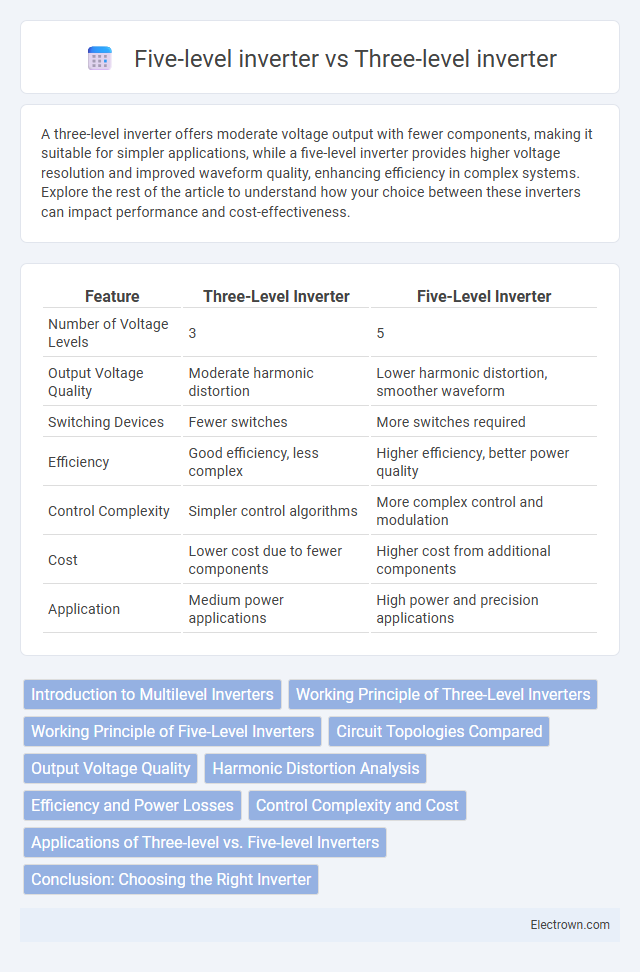A three-level inverter offers moderate voltage output with fewer components, making it suitable for simpler applications, while a five-level inverter provides higher voltage resolution and improved waveform quality, enhancing efficiency in complex systems. Explore the rest of the article to understand how your choice between these inverters can impact performance and cost-effectiveness.
Table of Comparison
| Feature | Three-Level Inverter | Five-Level Inverter |
|---|---|---|
| Number of Voltage Levels | 3 | 5 |
| Output Voltage Quality | Moderate harmonic distortion | Lower harmonic distortion, smoother waveform |
| Switching Devices | Fewer switches | More switches required |
| Efficiency | Good efficiency, less complex | Higher efficiency, better power quality |
| Control Complexity | Simpler control algorithms | More complex control and modulation |
| Cost | Lower cost due to fewer components | Higher cost from additional components |
| Application | Medium power applications | High power and precision applications |
Introduction to Multilevel Inverters
Multilevel inverters convert DC voltage to AC voltage by synthesizing multiple voltage levels, enhancing power quality and reducing harmonic distortion. Three-level inverters produce three distinct output voltage levels, improving voltage steps and reducing switching losses compared to traditional two-level inverters. Five-level inverters offer finer voltage resolution with five output levels, resulting in lower total harmonic distortion (THD), better waveform quality, and enhanced efficiency in medium- to high-power applications.
Working Principle of Three-Level Inverters
Three-level inverters operate by generating output voltages at three distinct levels, typically positive, zero, and negative, using a combination of power semiconductor switches and capacitors arranged in a neutral point clamped (NPC) topology. This approach reduces voltage stress on each switching device and minimizes harmonic distortion in the output waveform, enhancing power quality and efficiency. Understanding the working principle of three-level inverters helps you select suitable inverter technology based on your application's voltage requirements and performance criteria.
Working Principle of Five-Level Inverters
Five-level inverters operate by synthesizing output voltage from multiple DC voltage levels, using cascaded H-bridge configurations or diode-clamped topologies to produce stepped waveforms that approximate a sinusoidal output with reduced harmonic distortion. This multi-level approach enhances power quality and efficiency by splitting the voltage stress across several semiconductors, resulting in lower switching losses and improved thermal management compared to three-level inverters. Your choice of a five-level inverter can optimize performance in medium-voltage applications by providing smoother output voltages and improved electromagnetic compatibility.
Circuit Topologies Compared
Three-level inverters utilize three voltage levels by incorporating two semiconductor switches and a neutral point, simplifying the circuit topology but resulting in higher voltage stress on devices. Five-level inverters employ more complex topologies with additional switches and capacitors, enabling finer voltage steps that reduce harmonic distortion and improve output waveform quality. Your choice between these topologies depends on the balance between switching complexity, device stress, and desired power quality in your application.
Output Voltage Quality
A five-level inverter provides significantly improved output voltage quality compared to a three-level inverter by producing more voltage steps, which reduces harmonic distortion and smooths the voltage waveform. This results in lower total harmonic distortion (THD) and better power quality, enhancing the performance of sensitive loads. If your application requires high-quality output voltage and reduced filtering, a five-level inverter is a superior choice.
Harmonic Distortion Analysis
Three-level inverters typically produce lower Total Harmonic Distortion (THD) than conventional two-level inverters by generating output voltages with more steps, reducing switching frequency harmonics. Five-level inverters further improve harmonic distortion performance by providing even finer voltage waveform approximation, significantly minimizing lower order harmonics and enhancing power quality. Your choice between three-level and five-level inverters depends on the harmonic distortion limits required for your specific power system application.
Efficiency and Power Losses
Three-level inverters typically offer higher efficiency and lower power losses compared to two-level inverters by reducing voltage stress on switching devices, but five-level inverters enhance this further by providing smoother voltage waveforms and decreased harmonic distortion, which significantly minimizes switching and conduction losses. The multi-level topology in five-level inverters allows for lower voltage steps, improving power quality and reducing electromagnetic interference, ultimately resulting in better overall energy conversion efficiency. If your application demands superior performance with minimal power loss, choosing a five-level inverter can optimize your system's efficiency and operational lifespan.
Control Complexity and Cost
Three-level inverters exhibit lower control complexity due to simpler switching algorithms and fewer power semiconductor devices compared to five-level inverters. Five-level inverters, with increased switching states, require advanced control strategies such as predictive or selective harmonic elimination, increasing software and hardware demands. The cost of five-level inverters is higher because of additional components like extra IGBTs or MOSFETs, capacitors, and complex control circuitry, whereas three-level inverters provide a cost-effective solution with moderate efficiency and control simplicity.
Applications of Three-level vs. Five-level Inverters
Three-level inverters are widely used in renewable energy systems, electric vehicles, and medium-voltage motor drives due to their ability to improve power quality and reduce total harmonic distortion (THD). Five-level inverters find applications in high-power industrial drives, grid-tied photovoltaic systems, and flexible AC transmission systems (FACTS) because they provide better output waveform quality and higher voltage handling capability. The choice between three-level and five-level inverters depends on specific application requirements such as power rating, efficiency, and harmonic performance.
Conclusion: Choosing the Right Inverter
A five-level inverter offers improved output waveform quality and reduced harmonic distortion compared to a three-level inverter, making it ideal for applications requiring higher power efficiency and precision. Three-level inverters, being simpler and more cost-effective, suit low to medium power needs where budget constraints are crucial. Your choice should balance performance requirements with cost and complexity, ensuring the inverter aligns with your specific operational demands.
Three-level inverter vs Five-level inverter Infographic

 electrown.com
electrown.com